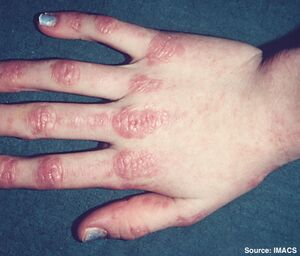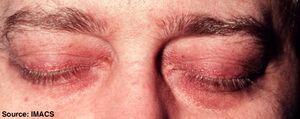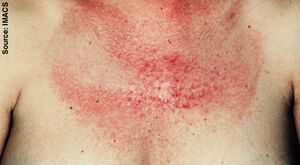Dermatomyositis
Original Editors Megan Sarason from Bellarmine University's Pathophysiology of Complex Patient Problems project.
Top Contributors - Megan Sarason, Admin, Lucinda hampton, Elaine Lonnemann, Kim Jackson, Khloud Shreif, 127.0.0.1, Wendy Walker and WikiSysop
Introduction[edit | edit source]
Dermatomyositis is an autoimmune inflammatory myositis, possibly related condition to polymyositis.[1] It is characterized by inflammatory and degenerative changes in the muscles and skin leading to symmetric weakness and some degree of muscle atrophy, principally in the limb girdles, neck and pharynx. This disease has also shown to effect the esophagus, lungs, and least commonly the heart. Also classified in the umbrella term Inflammatory Myopathies.[2][3][4]
Epidemilogy[edit | edit source]
Female predilection. Bimodal age pattern: Juvenile dermatomyositis (JDM), affects children and is more severe; Adult dermatomyositis (ADM) usually affects adults around the age of 50.[1]
Etiology[edit | edit source]
The cause of dermatomyositis is unknown, however several genetic, immunologic, and environmental factors are implicated in this condition.
Genetic: there are studies suggested that there are particular human leukocyte antigen (HLA) types considered a risk factor for dermatomyositis[5][6]. In addition autoantibodies were also detected in patients.
Infection: Viruses like Coxsackie B, enterovirus, and parvovirus are suspected triggers for dermatomyositis. They may initiate autoimmunity through mechanisms such as altering cellular proteins, disrupting self-tolerance, revealing hidden immune targets, activating B cells with autoantibodies, and molecular mimicry[7].
Certain drugs that including antineoplastic medications like hydroxyurea and cyclophosphamide, anti-infectious agents such as penicillin, sulfonamides, and isoniazid, non-steroidal anti-inflammatory drugs like diclofenac and phenylbutazone, as well as D-penicillamine, statins, and certain vaccines can trigger dermatomyositis[8].
Characteristics/Clinical Presentation[edit | edit source]
Classically presents with a symmetrical proximal myopathy with associated dermatological changes including, dusky-red rash over the face, arms, hands, legs and other features. Other features include, dysphagia, myalgia, fever and weight loss[1].
- Muscle weakness: that starts slowly and worsens over time. It first affects proximal muscles symmetrically, with distal muscles becoming involved later. This results in difficulties with everyday activities like standing up, climbing stairs, or lifting objects. Severe cases can lead to head drop, difficulty swallowing and speaking, and weakened breathing muscles. While less common, some patients may also experience muscle pain and tenderness.
- Skin disease: dermatomyositis (DM) is characterized by a rash it can appear before, alongside, or after muscle weakness the key skin features may include: [9]
- Gottron's papules: Erythematous to violaceous bumps on the knuckles, potentially with scaling and ulceration, leading to scarring.
- Gottron's sign: Erythematous patches on elbows and knees (less specific).
- Heliotrope rash: Purple eyelid erythema with swelling and tiny blood vessels (telangiectasia), sometimes subtle in darker skin.
- Erythematous patches in sun-exposed and non-sun-exposed areas.
- Malar erythema: Redness across cheeks, extending to the nose and nasolabial folds.
- "V" sign: Confluent redness on the lower neck and upper chest.
- Shawl sign: Erythema on the upper back, neck, and shoulders, possibly extending to the arms.
- Scalp involvement and skin issues on the lower back and lateral thighs (Holster sign).
- Rarely, extensive erythroderma covering more than 50% of the body surface or a severe, cracked skin variant can occur.
Systemic Involvement[edit | edit source]
Systemic manifestations:
Common: proximal muscle weakness, dysphonia, dysphagia
Less common: respiratory muscle weakness, visual changes, abdominal pain
Systemic complications/association:
Aspiration pneumonia secondary to respiratory muscle weakness
Diffuse interstitial pneumonitis/fibrosis
Large-bowel infarction secondary to vasculopathy has occurred in juvenile patients with myositis
Muscle atrophy
Muscle calcification
Ocular complications including iritis, nystagmus, cotton-wool spots, optic atrophy, conjunctival edema and pseudopolyposis
Internal malignancy
Cardiomyopathy Cardiac conduction defects[10]
Complications Malignancy[edit | edit source]
There is a six fold increased risk of malignancy in dermatomyositis. This risk appears to be highest in patients diagnosed with dermatomyositis after 45 years of age. Risk factors include: >60 years old; male; dysphagia; necrosis of the skin; cutaneous vasculitis; accelerated onset of disease; increased creatine kinase (CK) levels; increased ESR and C-reactive protein (CRP) levels[11].
Diagnostic Tests/Lab Tests/Lab Values[edit | edit source]
laboratory studies are helpful but nonspecific:
- ESR frequently elevated
- Antinuclear antibodies (ANA) elevated in 60 to 80 percent of patients
- Elevated creatine kinase (CK) enzyme, transaminases, and lactate dehyrogenase levels
- EMG to measure the electrical activity of the muscles: typically present as short-wave and fibrillations or myopathic pattern, 10 percent are false-negative
- Rheumatoid factor: elevated in 20 percent of patients, most often in those with overlap syndromes
- Neopterin and factor VIII–related antigen (von Willebrand factor): reported to correlate with juvenile DM[10][4]
Management[edit | edit source]
The goals of managing dermatomyositis are focused on treating muscle weakness, skin disease, and addressing any other underlying complications. Physical therapy and rehabilitation play an essential role in management. [12] The treatment regimen must be instituted early and requires a team approach between the physical therapist, dermatologist and family physician. While currently there is no cure for this systemic disease the symptoms can be treated.
Pharmacological Management[edit | edit source]
Corticosteroids are used initially to reduce the inflammation, shorten the time to normalization of muscle enzymes, and reduce morbidity.
Maintenance therapy with Prednisone usually is necessary indefinitely in the adult patient.
Immunosuppressive therapies may be used in individuals who do not respond well to the corticosteroids.
The skin disease is primarily treated with sun avoidance, topical corticosteroids, antimalarial agents, methotrexate, mycophenolate mofetil, and/or intravenous immune globulin. Patient education is highly important to assist in control of the disease process.[10]
Physical Therapy Management[edit | edit source]
Patients with mild disease should be encouraged to engage in active exercise programs. Range of motion exercises help in preventing contractures. Patients with esophageal dysfunction may require elevation of the head off the bed, thickening of feeds, and even feeding via gastric tubes when indicated.[12]
Focus of Treatment should include:
- Strengthening to prevent atrophy once inflammation is controlled
- Range of motion exercises to prevent contractures
- Passive stretching and splinting[10][13]
Differential Diagnosis[edit | edit source]
- CREST Syndrome
- Parapsoriasis
- Graft Versus Host Disease
- Pityriasis Rubra Pilaris
- Lichen Myxedematosus
- Polymorphous Light Eruption
- Lichen Planus
- Psoriasis, Plaque
- Lupus Erythematosus, Acute
- Rosacea
- Lupus Erythematosus, Discoid
- Sarcoidosis
- Lupus Erythematosus, Subacute Cutaneous
- Tinea Corporis
- Morphea
- Urticaria, Chronic
- Multicentric Reticulohistiocytosis
References[edit | edit source]
- ↑ 1.0 1.1 1.2 Radiopedia Dermatomyositis Available:https://radiopaedia.org/articles/dermatomyositis?lang=gb (accessed 23.1.2023)
- ↑ Goodman C, Fuller K. Pathology: Implications for the Physical Therapist. St. Louis, Missouri: Saunders Elsevier; 2009.
- ↑ MayoClinic.com Website. Dermatomyositis Available at: http://www.mayoclinic.com/health/dermatomyositis/DS00335 Accessed on 4/1/2010.
- ↑ 4.0 4.1 Hajj-ali RA. Polymyositis and Dermatomyositis. The Merck Manual of Diagnosis and Therapy. http://www.merck.com/mmpe/sec04/ch032/ch032d.html?qt=dermatomyositis&alt=sh. Updated February 2008. Accessed March 6, 2010.
- ↑ O'Hanlon TP, Rider LG, Mamyrova G, Targoff IN, Arnett FC, Reveille JD, Carrington M, Gao X, Oddis CV, Morel PA, Malley JD. HLA polymorphisms in African Americans with idiopathic inflammatory myopathy: allelic profiles distinguish patients with different clinical phenotypes and myositis autoantibodies. Arthritis & Rheumatism: Official Journal of the American College of Rheumatology. 2006 Nov;54(11):3670-81.
- ↑ Chinoy H, Salway F, Fertig N, Shepherd N, Tait BD, Thomson W, Isenberg DA, Oddis CV, Silman AJ, Ollier WE, Cooper RG. The UK Adult Onset Myositis Immunogenetic Collaboration (AOMIC): In adult onset myositis, the presence of interstitial lung disease and myositis specific/associated antibodies are governed by HLA class II haplotype rather than by myositis sub type. Arthritis Research and Therapy. 2005;8(1):R13.
- ↑ Adler BL, Cristopher-Stine L. Triggers of inflammatory myopathy: insights into pathogenesis. Discovery medicine. 2018 Feb;25(136):75.
- ↑ Dourmishev AL, Dourmishev LA. Dermatomyositis and drugs. Rheumaderm: Current Issues in Rheumatology and Dermatology. 1999 Jan 1:187-91.
- ↑ Sontheimer RD. Dermatomyositis: an overview of recent progress with emphasis on dermatologic aspects. Dermatologic clinics. 2002 Jul 1;20(3):387-408.
- ↑ 10.0 10.1 10.2 10.3 Koler RA, Montemarano A. Dermatomyositis. American family physician. 2001 Nov 1;64(9):1565-73.
- ↑ Zahr ZA, Baer AN. Malignancy in myositis. Curr Rheumatol Rep. 2011;13:208–15
- ↑ 12.0 12.1 Qudsiya Z, Waseem M. https://www.ncbi.nlm.nih.gov/books/NBK558917/ Available:https://www.ncbi.nlm.nih.gov/books/NBK558917/ (accessed 23.1.2023)
- ↑ Alexandria V. American physical therapy association guide to physical therapist practice. Phys. Ther.. 1997;77(11):1163-74.









